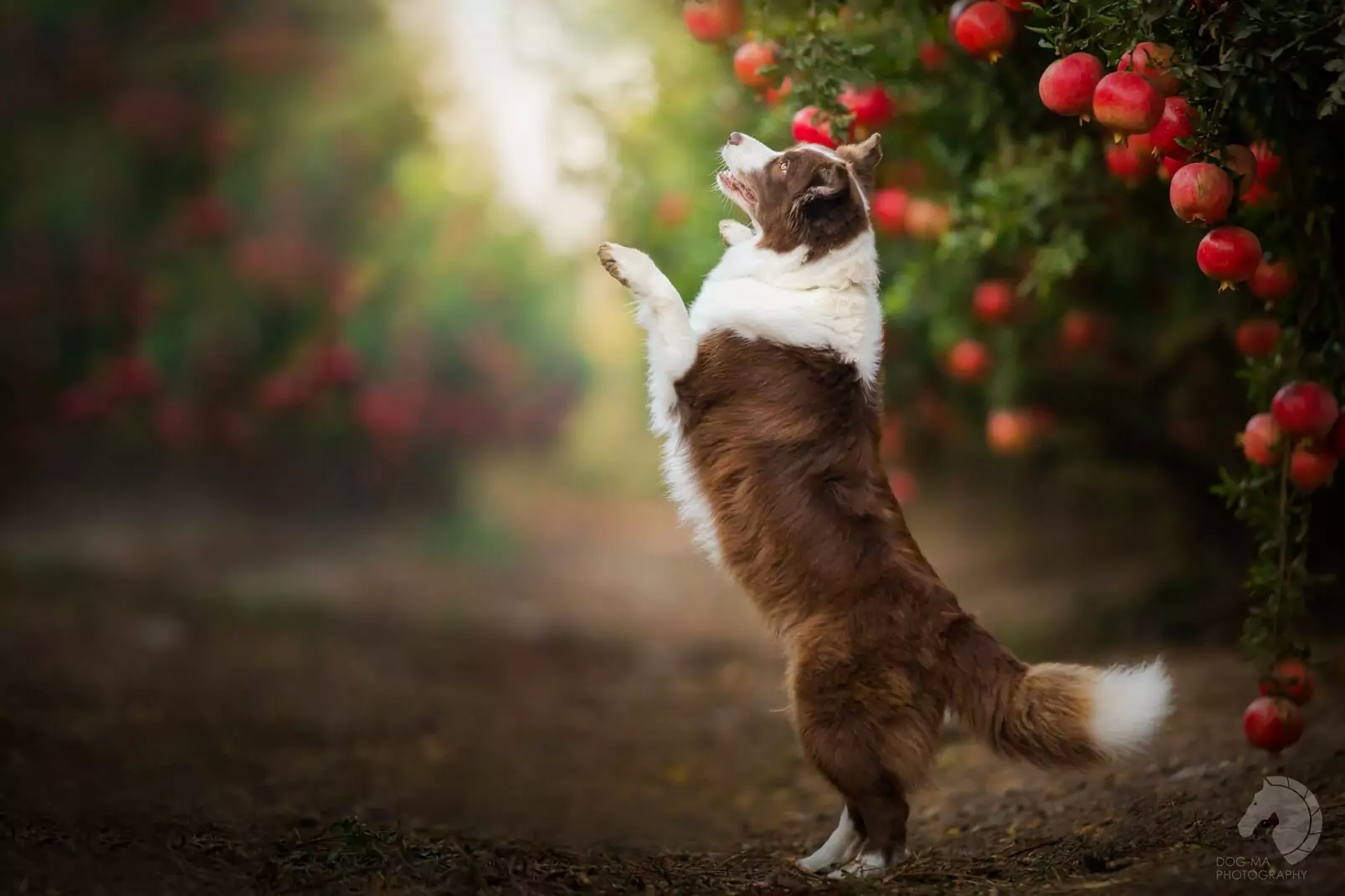What colors can dogs see? What are the differences between the visual structures of dogs and humans?
2022-07-08
The most commonly mentioned problem with dog vision is that dogs are color blind and can see black, white, and gray. Scientific research has proven that dogs can see in color, but they just can't see the full-color spectrum as humans do, and they don't see as many colors as humans do, nor are they as rich.
I. What are the differences between the visual structures of dogs and humans?
Both human and dog eyes contain special light-trapping cells, which are also called optic cone cells, and these cells allow our eyes to respond to color. However, seeing color depends not only on the number of vertebrae possessed but also on how many types of vertebrae are possessed, because each receives different wavelengths of light. Humans have three different kinds of visual cone cells, red, green, and blue vertebrae, and their combined activity provides a full range of color vision for humans. Dogs, on the other hand, have only two types of visual cone cells, fewer than humans, which is why their color vision is not as rich as ours. The most common color blindness in humans is because it is due to the lack of one of the three vertebrae, only two, but they can still see colors just as well, just less than normal, which is similar to color vision in dogs because dogs also have only two types of cone cells.
Experiments on color vision in dogs
Jay Neitz (Jay Neitz) of the University of California, Santa Barbara, did an experiment on color vision in dogs. During the experiment, the dogs were given three color swatches with a total of two different colors, two swatches that had the same color and another swatch that was a different color. The dog's task is to find the different colors of that color palette, as long as it finds the right one, there will be a corresponding reward, to motivate the dog to find out the different colors. After repeating the experiment several times, it was not only proved that the dog can see the color but also indirectly proved that the dog cannot see certain colors.
What colors can dogs see
Instead of seeing the rainbow as what we think of as red, orange, yellow, green, blue, and purple, dogs will see it as dark blue, light blue, gray, light yellow, dark yellow (kind of like brown), and very dark gray. In other words, in the visual world of dogs, the colors that can be seen are blue, gray, and yellow.
Now know that dogs can only see yellow, gray, and blue, associated with life, I wonder if you have found their dogs look at the color of any different reactions? You can look at your own dog's toys, and buy what color, usually what color is the dog's favorite toy, is not yellow, gray, or blue. If you throw a red ball in the yard, you will find that the dog will have trouble finding it because red is not a conspicuous color for him. Or you can try it out and see if your dog reacts differently to you the next time you wear a different color of clothing.
In everyday life, we can also find dog-related products, such as leashes, collars, and toys, many are orange and blue, next time the owner the purchase products, you can tend to
Pick the color that the dog can see, may be able to find more of its preferences.
Probably one of the most frequently asked questions about dog vision is whether dogs can see color. Many people will give a simple answer - dogs are color blind. This simple answer can lead to dogs being misunderstood as not being able to see any colors and only seeing the world in black and white and gray.
Such an idea is wrong. The very clear scientific conclusion is that dogs do see colors, but they do not see them as rich nor as much as humans do.

II. The world of color in the dog's eyes. Dogs are color blind, but they don't see only black and white and gray
Both human and dog eyes contain special light-catching cells called retinal cells that respond to color. Dogs have fewer retinal cells than humans, which suggests that their color vision is not as rich or strong as ours. However, the trick to seeing color is not just having a visual cone, but having several different types of visual cones, each tuned to a different wavelength of light. Humans have three different kinds of optic cones, and their combined activity gives them a full range of color vision. The most common type of human color blindness is because a person has lost one of the three cones. With only two visual cones, the person can still see color, but much less than a person with normal color vision. And this is exactly what happens in dogs.
We certainly can't rely on pure guesswork to determine what colors a dog can see; we must experiment with the dog's color discrimination behavior to get a more accurate conclusion.
Jay Netz of the University of California, Santa Barbara, tested the color vision of dogs. In many repetitions of the test, the dog was shown three consecutive light panels, two of which were the same color and the third was a different one. The dog's task was to find a different one and press a button on this light board. If the dog chose the right one, it would receive a reward as an incentive to try to recognize the different colors.
Nez confirmed that dogs can indeed see colors, but much less than normal. Instead of seeing the rainbow as purple, blue, blue-green, green, yellow, orange, and red, dogs will see it as dark blue, light blue, gray, light yellow, dark yellow (kind of like brown), and very dark gray. In other words, dogs think the colors of the world are yellow, blue, and gray. They consider green, yellow, and orange to be yellow and purple and blue to be blue. Blue-green is considered gray. If this pile of color expressions is dizzying to look at, you can see the spectrum of people and dogs below.
What is the specific significance of understanding that dogs see colors differently from what we see, other than knowing that they are not completely color blind and mistakenly think they can only see black, white, and gray?
I don't know if you dog owners have found that the various items you buy for your dog, red and orange are very common color schemes, in addition to collars, leashes, and toys for dogs also have more of these two colors. Because in our human eyes, these two colors are obvious and eye-catching. However red is difficult for dogs to see. It may appear as a very dark brownish gray or maybe even black. This means that the bright red dog toy that you can see is hard for your dog to see.
So, matching the floor in your home, what color new toy are you going to give your dog if you want him to see the toy you bought him more easily?
Three: Dogs are nearsighted
Dogs generally can't see stationary objects beyond a hundred meters. If parents call their dogs from a distance, they will generally freeze and keep their eyes on the source of the sound; when they come closer, the dogs will run over, because they are nearsighted.
But as hunting animals from the dog, they are very strong and sensitive to the ability to distinguish dynamic things. It is said that hounds and shepherds can notice people waving their hands from 1500 meters away. Different breeds of dogs will have different visions due to the position of their eyes. Dogs with small heads have a wider field of vision instead, so they are more sensitive to their surroundings.
Dogs are not particularly dependent on visual animals, because they have a strong sense of smell and hearing, so a weaker vision does not affect them in any way.
In other words, the reason your dog can recognize you as its owner is not because of your face, but your voice and smell. This is the reason why a dog that has been lost for years can recognize its owner who has changed a lot.
#
Color
#color vision
#cone cells
#color blindness
#vertebral body
#human
#gray
#vision
#color palette
Previous:At what age do dogs stop growing?
Was this article helpful to you?
Other links in this article
English:
What colors can dogs see? What are the differences between the visual structures of dogs and humans?
Nederlands:
Welke kleuren kunnen honden zien? Wat zijn de verschillen tussen de visuele structuren van honden en mensen?
português (Brasil):
Que cores os cães podem ver? Quais são as diferenças entre as estruturas visuais dos cães e dos seres humanos?
Comments

Is a dog's mouth cleaner than a human's? Dogs' mouths need regular cleaning

Can dogs eat beans? Do dogs eat beans for health?

Can dogs eat lemons? Fruits that dogs should not eat more of

Do dogs have nightmares? Are dogs' dreams similar to humans'?

Can dogs eat raw beef? The benefits and drawbacks of beef for dogs

Is raw meat good for dogs? Can dogs eat raw chicken?

Can dogs eat pomegranates?

Can dogs eat ham?Can all types of ham hocks be eaten?

How to give a dog a bath

Can dogs eat kimchi?










